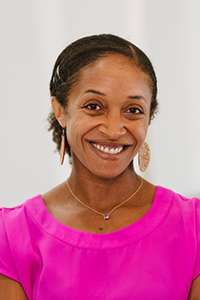April 5, 2021 | Alumni
Diabetes disparities: U of T alumni researchers work with communities at risk

(Photo by iStockPhoto/Getty Images)
Rick Bhurji was shocked to learn that, at age 47, he had type 2 diabetes.
His next thought was: What did I do wrong?
Rick’s daughter, Anjali, noticed that many of their Indo-Canadian friends and family had “mysteriously” developed diabetes. She figured her father’s diabetes was due to his love of pop and junk food.

“For many of us who are South Asians, we internalize and blame ourselves for the diabetes epidemic in our community, but that is really unfair,” says Ananya Banerjee (MSc 2007), an assistant professor at the University of Toronto’s Dalla Lana School of Public Health and a researcher with the Temerty Faculty of Medicine’s Banting & Best Diabetes Centre.
In fact, people from communities of colour across Canada are at higher risk for diabetes. The incidence rate of type 2 diabetes is double in Black communities and triple in South Asian and First Nations communities, compared to white Canadians.
A recent report found that First Nations children in Manitoba are 25 times more likely to be diagnosed with type 2 diabetes than other children. But disparities in diabetes are about more than ethnicity.
Researchers have found that location, income level, education, mental health, and experiences of racism and trauma can all profoundly impact the development and progression of diabetes.
By looking beyond basic biology, health-care providers are not only identifying which communities are at risk for diabetes, but also what interventions can make a difference.
By looking beyond basic biology, health-care providers are identifying what interventions can make a difference

“In health care, we tend to take a one-size-fits-all approach,” says Aisha Lofters (BSc 2000 UC, PhD 2012), a clinician scientist and an associate professor of family and community medicine at the Temerty Faculty of Medicine.
Lofters is also co-leader of the BETTER WISE project which aims to improve the screening and prevention of cancer and chronic illnesses, including diabetes.
In practice, set guidelines and flowsheets don’t work for all individuals, explains Lofters.
Rather than “wagging the finger” at a patient who, for instance, isn’t meeting the recommended amount of exercise, the BETTER WISE project works with the patient to set individualized, attainable goals – such as going for a 15-minute walk each week.
Banerjee took a similar approach with the South Asian Adolescent Diabetes Awareness Program (SAADAP), providing education and prevention strategies to 80 South Asian teens with a family history of diabetes.
Through this pilot program, about eight in 10 participants reduced their intake of sweets and junk food and encouraged their family members to eat healthier.
Anjali and Rick, for instance, learned recipes for a healthy mango lassi and chickpea salad that have become staples in their home.
“Disparity has come about because of a health-care system that isn’t serving people of colour”
Outcomes of tailored diabetes programs are promising but, as obesity management expert and U of T alumnus Sean Wharton (BScPharm 1992, PhMD 1997, MD 2001) explains, they point to larger flaws in Canada’s health-care system.
“Disparity has come about because of a health-care system that isn’t serving people of colour,” says Wharton.
Beyond adjusting care to fit individual patient needs, he says some of the most effective ways of treating disparities in diabetes are at the grassroots level, such as in places of worship and community centres.
“These are spaces where the people working with the community are not biased against them, and they’re not blaming and shaming them, making them feel unrecognized or discriminated against,” explains Wharton.
In an effort to dispel internalized blame or stigma related to diabetes, Banerjee, through SAADAP, highlights the social determinants of health, such as the walkability of neighbourhoods and the burden of precarious employment, and how they affect the participants’ health.
Those lessons made Anjali realize, “There’s no need to feel horrible, and that you caused this, because you didn’t.”
Recent findings from the Manitoba Centre for Health Policy and the First Nations Health and Social Secretariat of Manitoba (FNHSSM) showed that First Nations individuals access primary care at a similar rate to others in the province. However, that care is not reducing complications from type 2 diabetes, such as amputations and kidney failure.
“The health system has made it the responsibility of the client with this simplistic idea that if you live healthy, eat healthy and exercise, you’re less likely to have type 2 diabetes. We know there’s more to it than that,” says Lorraine McLeod, associate director of the Diabetes Integration Project (DIP), a mobile program that First Nations leaders support to provide on-reserve diabetes care and treatment to more than a dozen First Nations communities in Manitoba.
Programs such as the centre’s DIP, B.C.’s Diabetes and My Nation and the cross-Canada FORGE AHEAD program have made significant improvements in diabetes prevention and management by being created by or developed in partnership with First Nations communities.
“Oftentimes, research has been led by non-Indigenous researchers, which often upholds colonial practices and policies”
Since the late ’90s in Manitoba, First Nations leaders have been calling for action and collecting the necessary data to address the growing epidemic of diabetes in Indigenous communities.
“Oftentimes, research has been led by non-Indigenous researchers who have used their voice and academic lens to analyze Indigenous people, which often leads to continued stigmatization, and upholds the colonial practices and policies that were put in place to assimilate First Nations, Métis and Inuit people into Canadian society,” says Leona Star, the centre’s director of research.
As an example of a dataset that accurately identifies First Nations according to their own indicators of well-being, Star points to the national Regional Health Survey (RHS), which she says was “designed and delivered by First Nations with our cultural framework and code of ethics.”
According to Star, RHS data has led to federal funding for multiple Indigenous health initiatives, including diabetes prevention. While Star emphasizes the need for First Nations people to govern their own information and data, known as “data sovereignty,” she calls for more action.
“It is also important to look at the effectiveness and impacts of research findings,” says Star. “Although significant investments have been made to undertake research around diabetes, the rates of diabetes continue to increase and climb especially amongst First Nations.”
While evidence led or co-led by First Nations is available, she says what is lacking are policies and implementation recommendations to address discrimination and disparities in health care.
“We need to shake the foundations of how we help”
Wharton says the key question is why researchers and health-care providers aren’t acting on what they already know.
To address the disparities created by bias, racism and systemic inequalities, he says it’s time that practitioners embrace the strengths of Indigenous peoples and people of colour, rather than assessing how these patients adhere to a system that wasn’t designed for or by them.
“We need to shake the foundations of how we help,” he says.
This story was originally published in U of T Med Magazine’s Insulin Issue.